After nearly a month of exciting football out in Qatar, the finalists for the AFC Asian Cup 2024 are finally set, with Qatar set to take on Jordan on Saturday, February 10, at the Lusail Stadium.
For hosts Qatar, the occasion is nothing new. They are the defending champions, having sailed to title success in 2019 on the back of 19 goals scored in seven matches, including three in the final against Japan. Their attack this time around has not reached those heights, but they have still netted 11 times in six matches while conceding just four and are certainly the favourites heading into this clash.
However, their opponents are arguably the story of the competition this time around, making it to their first-ever final despite being only the 13th-best team in Asia and qualifying for the knockouts as one of the best third-placed teams. Jordan have had a fairytale run, beating the likes of Iraq and South Korea in the knockouts to make it to the summit clash. Their progress to this stage has been built on a robust defensive foundation, as they have let in just five goals in six games so far, as well as an attack that has averaged two goals a game.
This tactical analysis will preview the AFC Asian Cup final by looking at the intricacies of both teams’ tactics in attack and defence, tactical themes to look out for, and some of their best performers so far, as well as players to keep an eye on in the final. Without further ado, let’s dive right into the analysis!
Formations and Personnel
This particular dimension provides one of the most interesting contrasts between the two teams.
Jordan have been a beacon of consistency in this tournament, largely sticking with a 3-4-3 formation. The only time they have changed that up was against Bahrain in the group stage and Iraq in the Round of 16, choosing a 3-4-2-1 and a 5-4-1, respectively. However, their principles and build-up remained largely similar in those two formations.
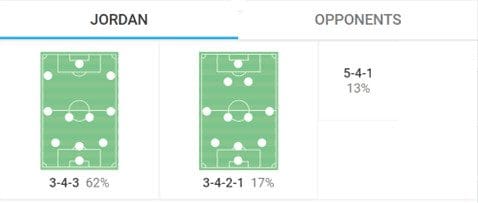
Yazeed Abulaila has started in goal in all six matches, with Abdallah Nasib, Yazan Al-Arab and Salem Al-Ajalin forming coach Hussein Ammouta’s preferred back three. However, Anas Bani Yaseen and Bara’ Marei have also received a start apiece. Mahmoud Al-Mardi and Ehsan Haddad have largely taken up the wing-back positions, with Mohammad Abu Hasheesh and Feras Shelbaieh starting a game apiece.
In holding midfield, Jordan have experimented with Noor Al-Rawabdeh, Nizar Al-Rashdan, Rajaei Ayed and Fadi Awad all jostling for the two spots, with the former two starting the semifinal against South Korea. Left winger Ali Olwan played in each of their first five matches but was dropped for Al-Mardi in the semifinal, while Mousa Al-Tamari has been Ammouta’s preferred right-wing option. Lastly, striker Yazan Al-Naimat has started all of their matches as their striker.
Qatar, on the other hand, have taken a path similar to Argentina at the 2022 FIFA World Cup with respect to their formations, displaying plenty of tactical flexibility. They have used six different set-ups in six matches so far, and it promises to be interesting to see how they line up in the final.
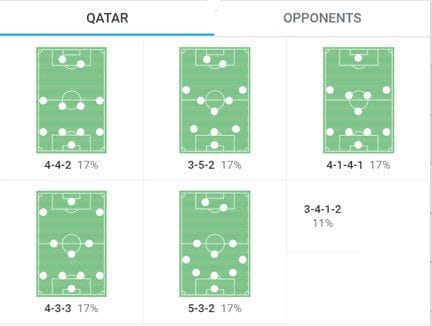
Meshaal Barsham has been a constant in goal, only giving way to Saad Al-Sheeb in their group-stage dead rubber against Tajikistan. Across their various formations, Mohammed Waad and Pedro Miguel have operated the most as full-backs or wing-backs. Almahdi Ali and Lucas Mendes have consistently played in central defence, though Tarek Salman has either tagged in for one of them or played as part of a back-three alongside the duo.
Ahmed Fathi has been a consistent presence in midfield, with Jassem Gaber seemingly becoming his first-choice midfield partner. Abdulaziz Hatem, Mustafa Mashaal, Ali Asad and Hasan Al-Haydos have also received minutes depending on the game requirements and formation chosen by coach Tintin Marquez.
Akram Afif has been a constant in attack and displayed versatility, operating as a left-winger and right-sided striker. Yusuf Abdurisag and Ismaeel Mohammed have manned the right wing when required, though neither have started their last three matches. Lastly, Almoez Ali has led the line for Qatar, beginning all of their matches, barring the game against Tajikistan.
Jordan’s build-up from defence vs Qatar’s high press
Jordan’s build-up in this Asian Cup has certainly involved playing out from the back. When they do so, one of the two wing-backs drops back to help the three-man defence circulate the ball forward, with the two holding midfielders hovering around the halfway line. The other wing-back hugs the touchline on his flank. If the passing options are limited, one of the wingers then falls back to provide an outlet while the striker and other winger stay upfront.
All of this can be viewed in this sequence from their semifinal against South Korea. Here, the Koreans’ press stops Jordan from moving forward, forcing the centre-backs to recycle the ball. However, a couple of passes after the top-right frame, we notice that space has opened up in the bottom left, and when the ball reaches the left side of the field, there is an open pass into midfield that could then trigger a move up the pitch, with space to be exploited on both flanks.
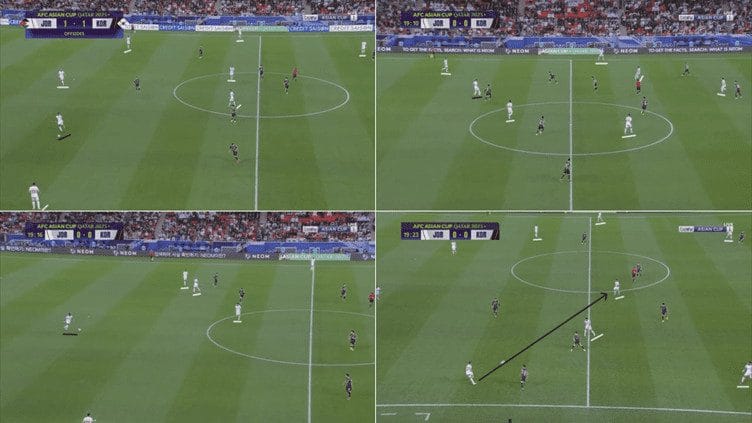
Jordan have also showed their ability to work past a higher-intensity press than the one used by South Korea in the clip above, as in the sequence below against Tajikistan (black arrows denote passes, white arrows denote movement). Once again, the back three converts into a four to help negotiate the press, but this time, the other wing-back also drops back, along with the two central midfielders, to their defensive third.
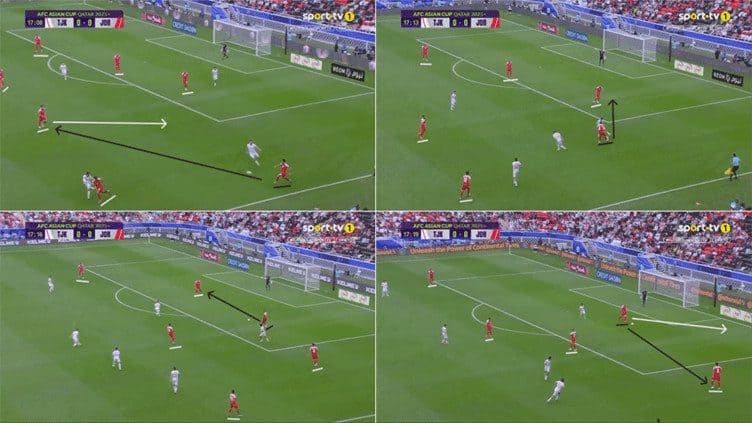
Once they get past the first line of the press, the right wing-back moves forward to provide an option out wide, while the right-winger drops back to receive the ball and turn, or pass back and build the move slowly. Through clever movement and positioning, Jordan turn this situation on its head and can now attack Tajikistan, who try to fall back into their defensive shape after an unsuccessful attempt to press their opponents.
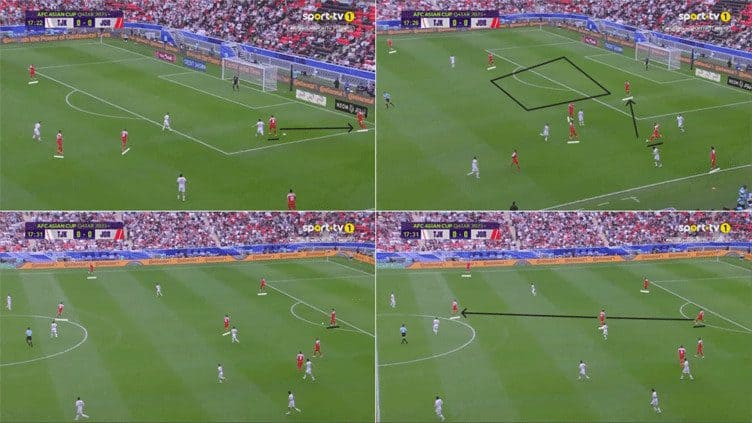
Their ability to get through the press will certainly be tested by Qatar, who have averaged just 7.07 passes per defensive action in this tournament, indicating that they suffocate opponents and look to trap them by cutting out spaces. Additionally, 19.79% of their opponents’ passes this term have been long passes, which suggests that their pressing has been reasonably effective.
Consider this clip from the first half of their semifinal against Iran, where they lined up in a 4-4-2. Qatar do leave one defender open, but there is pressure on him and the goalkeeper whenever they get the ball from Akram Afif, while the three players ahead of them are tightly marked in an aggressive trapping system. This results in an exchange of passes between the centre-back and goalkeeper before the latter launches forward, as he has no other options.
As seen in the top right frame, Qatar commit as many as seven men into their attacking half, which is as many outfield players as Iran have in their own half. The bottom right frame shows that one of the pressers has now left his man on the right to press the goalkeeper, leading to the latter booting the ball forward.
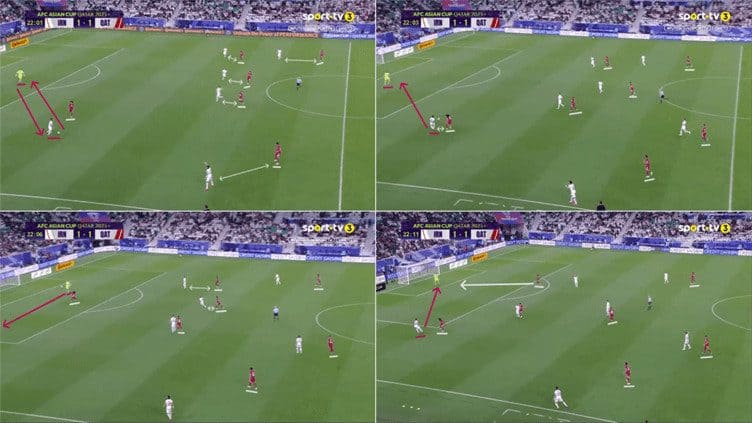
A simpler but equally effective version of this can be seen in Qatar’s quarterfinal against Uzbekistan, where they played in a 3-5-2 formation. After passing the ball to the opposing goalkeeper, the latter rolls it to a centre-back, instantly triggering a press, with as many as six Qatar players in the attacking half. Two passes later, Qatar have the ball back near the halfway line, with plenty of options upfront.
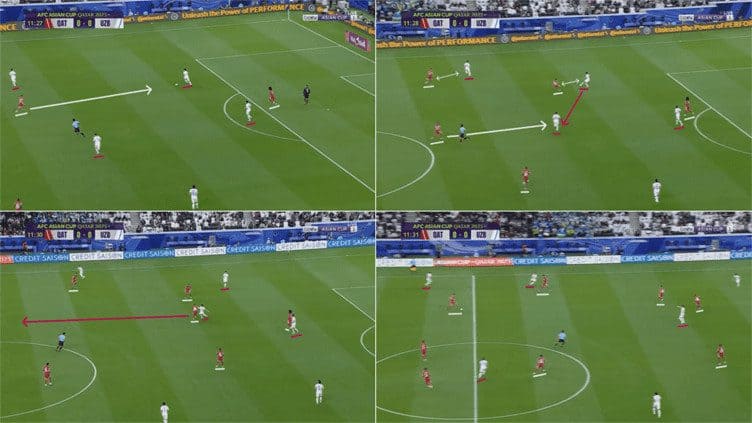
This could thus be a key tactical battle to watch out for in the final. Jordan, while adept at building out from the back, have occasionally reverted to going long as well – 15.34% of their passes in this tournament have been long balls. However, that is still lower than the average of Qatar’s previous opponents, and their building out from the back could be crucial to their chances in this game.
Jordan’s alertness vs Qatar’s high-line and errors
A significant component of Jordan’s fairytale run has been their alertness to opportunities. This was most evident in their semifinal against South Korea, where they capitalised on two underhit passes to win the ball in the attacking half and sting the favourites. Here is the first one, where Mousa Al-Tamari pounces on a poor pass thanks to his sharp eye for errors and finds Yazan Al-Naimat, who dinks it over the goalkeeper.
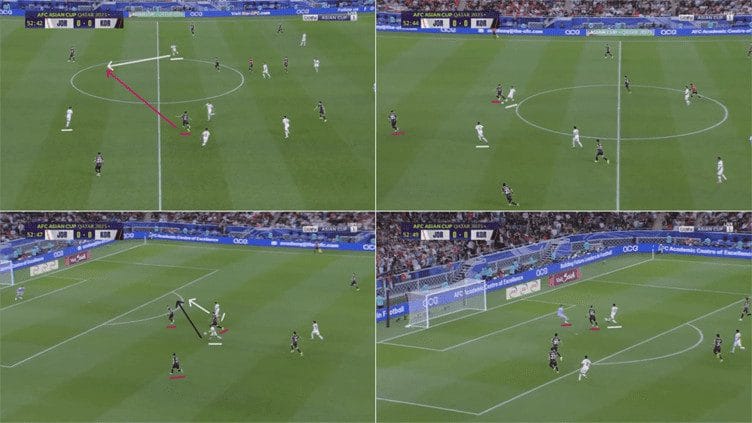
However, this has also been a larger trend for the team throughout the competition. Their opener against Iraq was similar to their first goal against the Koreans, while their match-winner in that game originated from a poor pass by the opposing goalkeeper. The pressure they apply on corners has led to two own-goals in this tournament as well.
This is not to say they do not create their own opportunities, though. Jordan have been a good shooting team, getting 46.5% of their 11.5 shots per game on target, despite taking over half of their efforts from outside the box (5.83 at 34.3% on target). They are also largely effective on the counter, with 53.2% of their 2.5 counterattacks per game ending in a shot.
The latter aspect is what Qatar will have to be wary of, considering that their opponents, up to now, have averaged only 1.0 counterattacks per game. Their high line and high press has occasionally led to errors such as the one below against Uzbekistan, where a simple long ball is misjudged by the right-back, allowing the winger to receive the ball in a dangerous area.
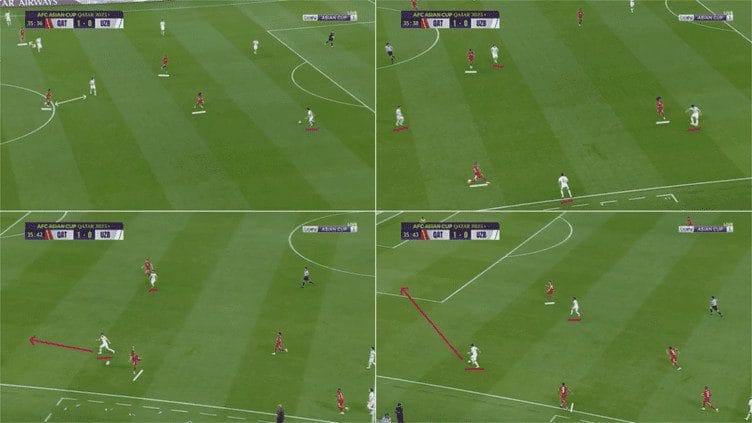
He then has space to run into, and Qatar is just marginally slow to recover. The winger gets to the byline inside the box and passes to the vacant far post, where his teammate meets the ball unmarked and strikes it well, only to be denied by a splendid recovery block.
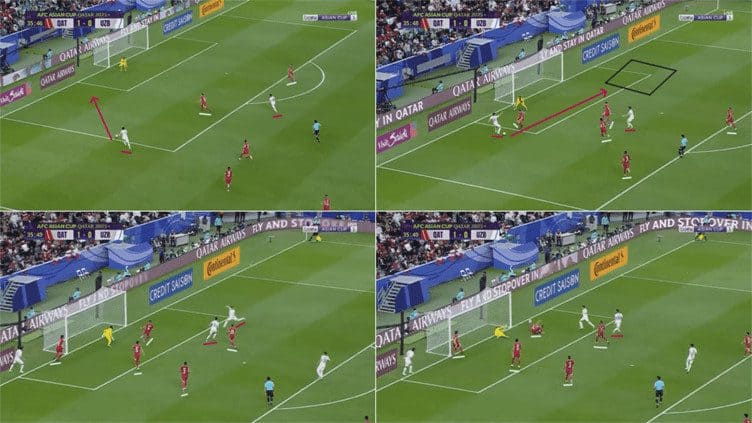
While they were saved by a last-ditch defensive play in this case, they didn’t enjoy such luck when they made an error in their Round of 16 ties against Palestine, where Oday Dabbagh picked up a poor pass from midfield to race in behind the defence and score. Dabbagh does incredibly well here, but this mirrors the situation from which Al-Naimat scored against both South Korea and Iraq.
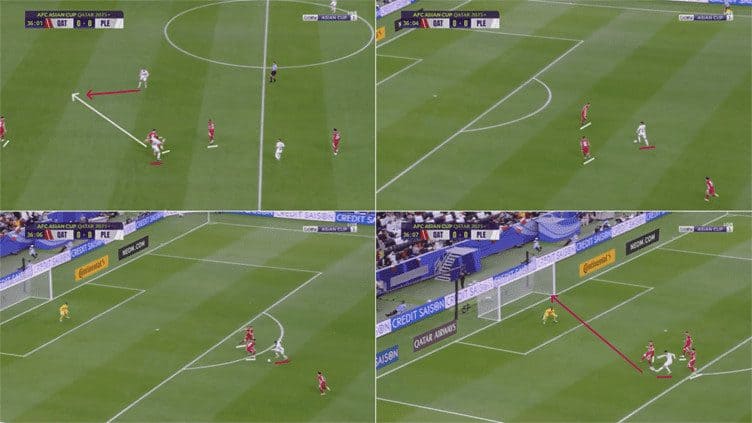
A highly alert Jordan outfit will undoubtedly punish any errors of this kind, so Qatar need to be incredibly astute with their passing and pressing.
Key Players
Both teams have differed with respect to the distribution of their goals.
Akram Afif has been the star for Qatar, scoring five times in six matches. Two of those have come from the penalty spot, but he has been on fire otherwise as well. What has stood out about Afif is his acceleration with the ball at his feet and ability to generate a powerful shot with minimal backlift, giving opposition players limited time to react.
The pace aspect can be seen in the way he accelerates to score against Lebanon in the sequence below, where he receives the ball in the attacking third and easily races past his defender before scoring with a smart finish. Notice how the defender in front of him is helpless and ends up just behind him when Afif eventually takes his final shot.
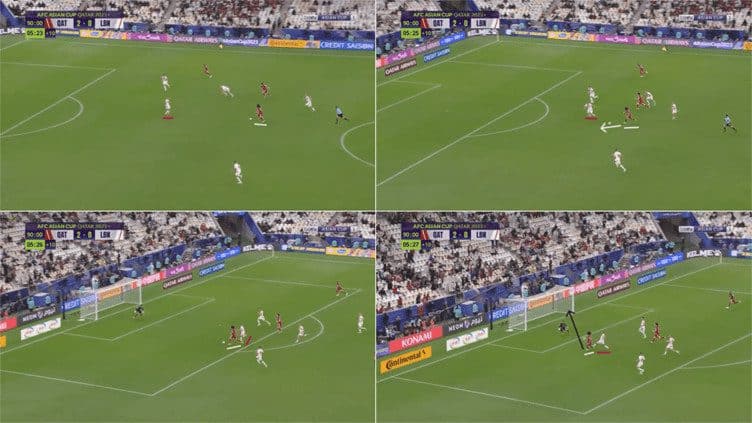
Afif has also racked up three assists, which means he has directly contributed to eight of Qatar’s 11 goals in this Asian Cup. Keeping him quiet would effectively equate to keeping Qatar quiet, but that is easier said than done.
One way to do so would be to stay co-ordinated at the back and play the offside trap that has seen them catch their opponents offside 17 times in six matches in this tournament. The other would simply be to get a holding midfielder to mark him closely, as the areas he occupies are varied across the final third, and he could engage with any of the three centre-backs. Nizar Al-Rashdan could play that role, as indicated by his heatmap alongside Afif’s below.
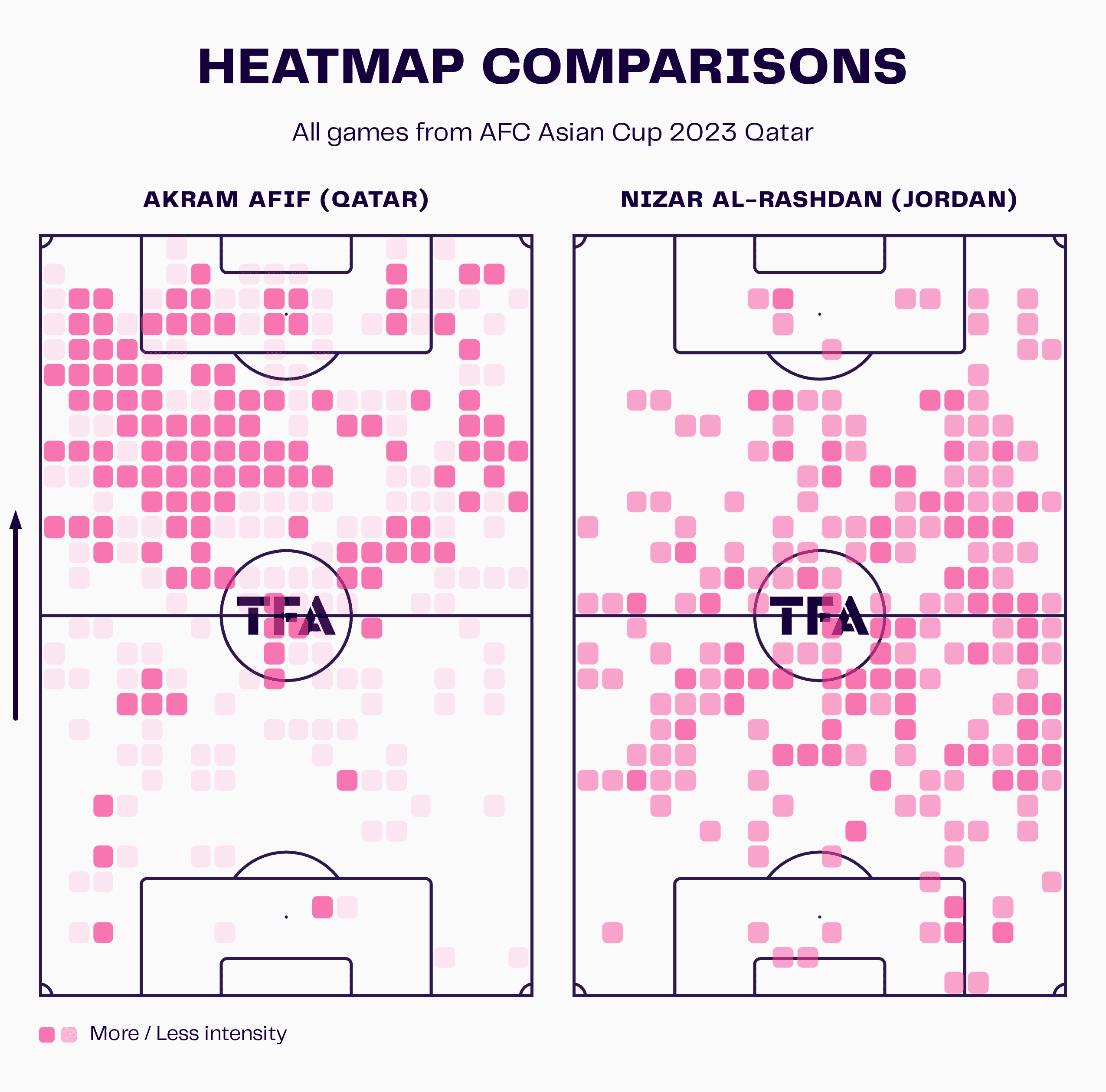
Al-Rashdan boasts a 62.8% duel win percentage in this tournament and has also been successful with 55.6% of his slide tackles, both of which could be crucial against Afif’s pace.
On the other hand, Jordan have been led by both Yazan Al-Naimat and Mousa Al-Tamari, who have three goals apiece. Two of Al-Naimat’s goals have come with him intercepting a poor pass and racing forward to score, while the other was a well-struck effort from the edge of the area in their group-stage draw with South Kora. He has also provided two assists so far.
Meanwhile, Al-Tamari scored one of the goals of the tournament with a lob from outside the box against Malaysia. Earlier in the same game, he scored from the penalty spot, while he also capitalised on a South Korea error to score in the semifinal.
What stands out when you look at the duo’s shotmaps is the way they complement each other. Al-Naimat’s efforts have largely been focused on central areas of the box, while Al-Tamari has attempted more shots from wider areas. Interestingly, both have shown that they can strike it well from the edge of the penalty area as well.
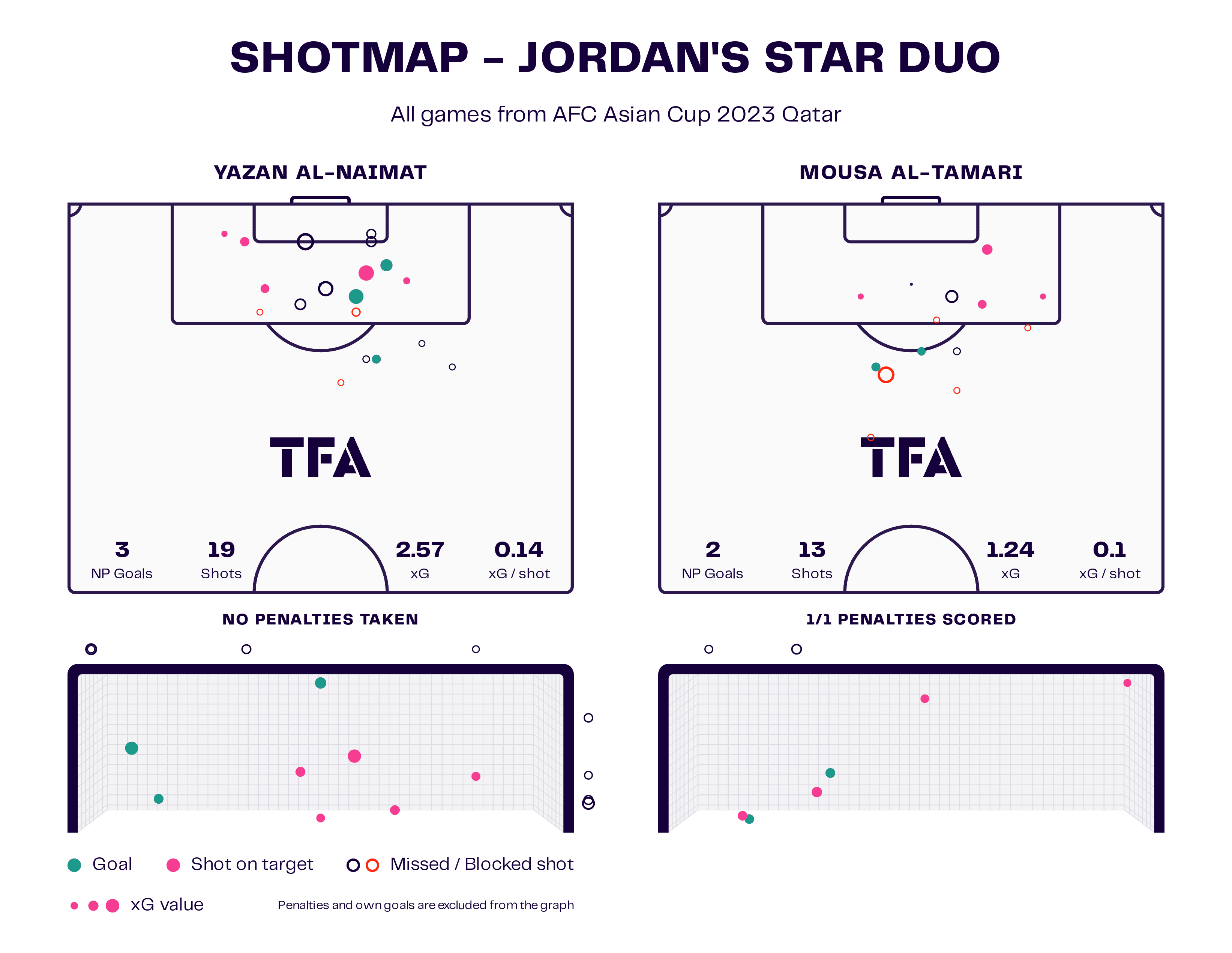
Qatar are bound to dominate possession in this contest (average of 55.9% per game in the tournament compared to Jordan’s 46.18%). However, as explained earlier, if they make any defensive errors or overcommit and leave space behind them, Jordan’s two-pronged attack could also hit them on the counter or through patient build-up.
One man who could be vital in stopping these is centre-back Lucas Mendes, who has enjoyed an excellent tournament so far. Mendes has averaged 5.28 interceptions per game, winning 69.1% of his duels. Given Qatar’s calculated high press, Jordan could look for long passes forward when forced. While this could prove to be a decent outlet, getting past Mendes won’t be easy as he has been a master at winning aerial duels (81.8% success rate), which could, in turn, limit the supply to Al-Naimat and Al-Tamari.
Conclusion
If just their past performances didn’t indicate it sufficiently on its own, the two teams’ set-ups, tactics and players on display suggest that we are in for a cracker of an Asian Cup final.
Qatar hold the edge going in due to their pedigree in this competition. Their high press has suffocated teams so far, and in Akram Afif, they have a forward who no defender would like to go up against in a one-on-one, while their backline, which was tested by Iran, boasts plenty of quality.
However, Jordan cannot be discounted, given the heart and resilience they have shown so far and their scalps already in this tournament edition. In what is their first-ever Asian Cup final, they will want to leave an impact. Al-Tamari and Al-Naimat will be critical, particularly on the counter, but their midfield and defence will arguably face their stiffest test of the competition so far.
All in all, as the analysis suggests, lock in for what promises to be a thoroughly exciting contest between two teams that could pose numerous tactical dilemmas and headaches for the other!





Comments